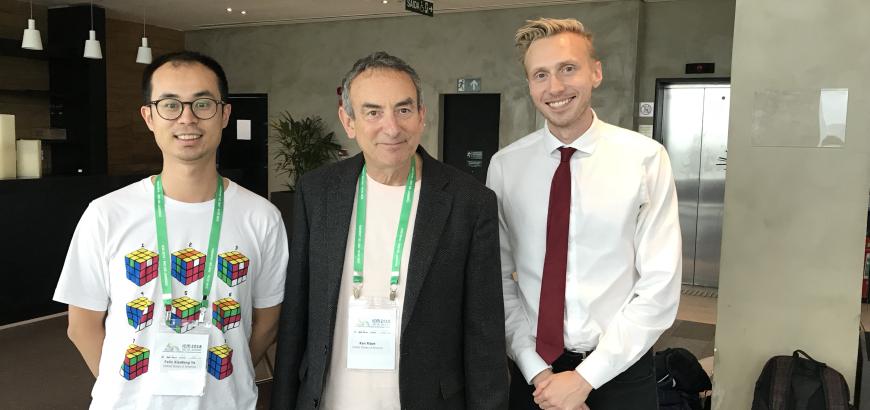By Felix Ye, Applied Mathematics PhD graduate
I cannot believe my PhD study is over. I had been in Seattle for so long that I almost don’t remember which year I started. I participated in so many others’ graduation ceremonies and now, finally, it was my turn. My memory of classes, lectures, and life in Guggenheim and Lewis Hall are still vivid. One particular memory was watching the precious winter sunsets from the window of the big PhD office in Guggenheim. I feel it was like yesterday.
I enrolled as a master student in 2011 and was admitted to the PhD program after my first year. The University of Washington was the only applied mathematics program to offer me funding for my Masters and PhD. Fortunately, they were also my top choice.
At first, I was interested in mathematical biology so I decided to start reading with Professor Hong Qian. He gave me a couple of problems to solve with lots of papers to read. It turned out that my research journey hit some bumps quickly. I was not sure how to start since we only had some vague ideas; it was not like homework problems that you might only need a couple of hours to finish. It was not what I expected at all, so I got frustrated quickly. We switched many problems in a couple of areas but still could not find the sweet spot to kick off my research.
Gradually, my interests started to shift to pure math. The problem may be motivated from the applications, but I would like to understand mechanisms that govern the system. I remember I spent one quarter learning the basic ergodic theory. At the end of the quarter, Prof. Qian asked me what were the differences between some particular properties of dynamical systems, including ergodic, mixing, and exact. I immediately recited the definitions of them. He then asked if I had intuitive descriptions, rather than definitions, and I realized that I didn’t have good pictures of them. Lots of definitions and theorems in pure math are presented in a way to be rigorous and elegant. Unfortunately, some of them are not very accessible to newcomers. I had already been struggling with definitions before hitting the heart of the field. But motivating ideas are as important as these rigors. Prof. Qian told me to not struggle too much on the setting in the beginning. Good ideas are not rigorously defined, or even have some exceptions. Finding or inventing the right tools to verify these ideas are crucial for applied mathematicians. So, what I did to understand the differences among the three properties was to plot the behaviors of dynamics with lots of examples by using MATLAB, such that I built up some intuitive ideas.
The tipping point of my research came from an accident during a ski trip. I tore my ACL when I fell skiing. While my friends were having fun up in the mountains, I had to stay in my bed at home, so I had plenty of free time. At that time in my research, I was trying to understand something called random dynamical systems, which is a very specialized branch in dynamical systems. I wasn’t sure that such pure theory could be used in the applied field. Prof. Qian told me that both dynamical systems and stochastic processes had established a tremendous amount of applications. How come combinations of both couldn’t? I was convinced and devoted to researching this subject. Instead of reading the standard textbooks, I started my exploration in the setting of discrete time and discrete states that hadn’t been studied before. I hoped without the technicality of continuum, it had a broader appeal to scientists and engineers. It turns out I did find some interesting results on something called noise-induced synchronization. I would really like to credit my collaborator, as well as my group mate and mathematician, Dr. Yue Wang, for consistently disproving my ideas and conjectures with all of his efforts.
After my research was back on track, I searched for applications for my theories. I first started with probabilistic Boolean networks in gene regulation. Yes, I was back to mathematical biology again. But this time, I had much better ideas of what I wanted to look for. Suddenly, I began to understand papers that were not accessible to me before. My prior frustrating experiences turned out to be helpful. I also actively tried to find applications for my research in other areas, especially in data science. I was very fortunate to have another group mate, Dr. Yian Ma, who is now working as a Postdoc with Michael I. Jordan at the University of California, Berkeley. One day, he told me he found some strange properties in hidden Markov models and could not understand it. His project was on statistical inference with big data. I said I would look at it, and after a couple of days, I hit the jackpot. The strange properties were due to noise-induced synchronization, something that I had studied extensively. With this knowledge, I helped improve his algorithm. This gave me an instantaneous rewarding feeling. It is exactly this feeling that motivates me to push myself to the frontier of applied math research.
Research is always a roller-coaster ride. You just don’t know when you’ll reach the tipping point. But just be patient and keep working, and your efforts will pay back sooner or later.
Felix Ye graduated with a PhD in Applied Mathematics in Spring 2018. He is now a Postdoctoral Fellow at The Johns Hopkins University in Baltimore, MA.
